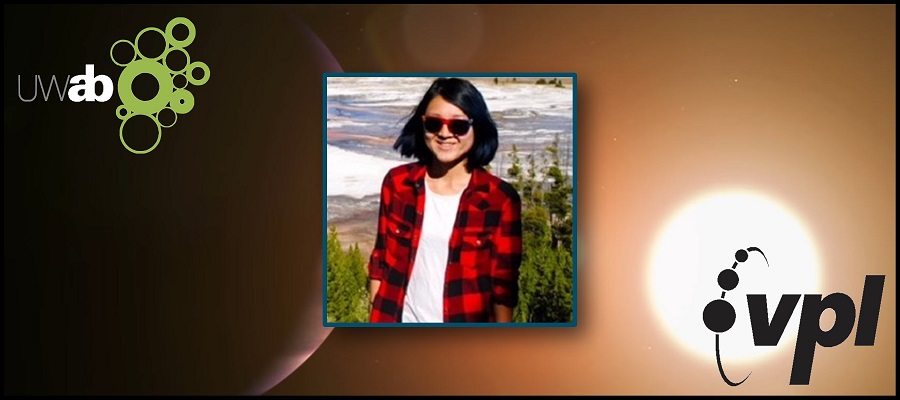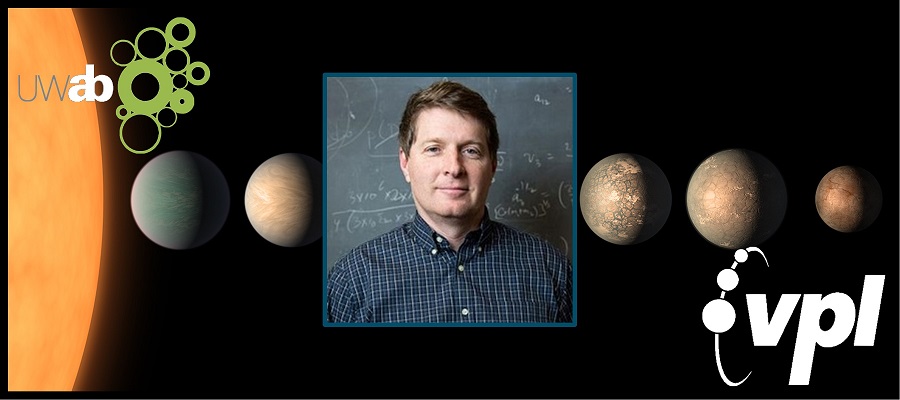UWAB faculty member Eric Agol and Program Director Victoria Meadows were recently interviewed by Phil LaMarr with the Universe Unplugged:…
VPL Researcher, Eric Agol (University of Washington) is the lead author on a new study of the 7 planets in…
Gaussian processes (GPs) are commonly used as a model of stochastic variability in astrophysical time series. In particular, GPs are frequently employed to account for correlated stellar variability in planetary transit light curves. The efficient application of GPs to light curves containing thousands to tens of thousands of data points has been made possible by recent advances in GP methods, including the celerite method. Here we present an extension of the celerite method to two input dimensions where, typically, the second dimension is small. This method scales linearly with the total number of data points when the noise in each large dimension is proportional to the same celerite kernel and only the amplitude of the correlated noise varies in the second dimension. We demonstrate the application of this method to the problem of measuring precise transit parameters from multiwavelength light curves and show that it has the potential to improve transit parameters measurements by orders of magnitude. Applications of this method include transit spectroscopy and exomoon detection, as well a broader set of astronomical problems.
Diana Windemuth (University of Washington, Advisor: Eric Agol) successfully defended their dissertation for the Dual-Title PhD in Astronomy & Astrobiology…
One of the main science motivations for the ESA PLAnetary Transit and Oscillations (PLATO) mission is to measure exoplanet transit radii with 3 per cent precision. In addition to flares and starspots, stellar oscillations and granulation will enforce fundamental noise floors for transiting exoplanet radius measurements. We simulate light curves of Earth-sized exoplanets transiting continuum intensity images of the Sun taken by the Helioseismic and Magnetic Imager (HMI) instrument aboard the Solar Dynamics Observatory (SDO) to investigate the uncertainties introduced on the exoplanet radius measurements by stellar granulation and oscillations. After modelling the solar variability with a Gaussian process, we find that the amplitude of solar oscillations and granulation is of order 100 ppm similar to the depth of an Earth transit and introduces a fractional uncertainty on the depth of transit of 0.73 per cent assuming four transits are observed over the mission duration. However, when we translate the depth measurement into a radius measurement of the planet, we find a much larger radius uncertainty of 3.6 per cent. This is due to a degeneracy between the transit radius ratio, the limb darkening, and the impact parameter caused by the inability to constrain the transit impact parameter in the presence of stellar variability. We find that surface brightness inhomogeneity due to photospheric granulation contributes a lower limit of only 2 ppm to the photometry in-transit. The radius uncertainty due to granulation and oscillations, combined with the degeneracy with the transit impact parameter, accounts for a significant fraction of the error budget of the PLATO mission, before detector or observational noise is introduced to the light curve. If it is possible to constrain the impact parameter or to obtain follow-up observations at longer wavelengths where limb darkening is less significant, this may enable higher precision radius measurements.
We derive analytic, closed-form solutions for the light curve of a planet transiting a star with a limb-darkening profile that is a polynomial function of the stellar elevation, up to an arbitrary integer order. We provide improved analytic expressions for the uniform, linear, and quadratic limb-darkened cases, as well as novel expressions for higher-order integer powers of limb darkening. The formulae are crafted to be numerically stable over the expected range of usage. We additionally present analytic formulae for the partial derivatives of instantaneous flux with respect to the radius ratio, impact parameter, and limb-darkening coefficients. These expressions are rapid to evaluate and compare quite favorably in speed and accuracy to existing transit light-curve codes. We also use these expressions to numerically compute the first partial derivatives of exposure-time-averaged transit light curves with respect to all model parameters. An additional application is modeling eclipsing binary or eclipsing multiple star systems in cases where the stars may be treated as spherically symmetric. We provide code which implements these formulae in C++, Python, IDL, and Julia, with tests and examples of usage (https://github.com/rodluger/Limbdark.jl).
The upcoming launch of the James Webb Space Telescope (JWST) combined with the unique features of the TRAPPIST-1 planetary system should enable the young field of exoplanetology to enter into the realm of temperate Earth-sized worlds. Indeed, the proximity of the system (12pc) and the small size (0.12 Rsun) and luminosity (0.05 Lsun) of its host star should make the comparative atmospheric characterization of its seven transiting planets within reach of an ambitious JWST program. Given the limited lifetime of JWST, the ecliptic location of the star that limits its visibility to 100d per year, the large number of observational time required by this study, and the numerous observational and theoretical challenges awaiting it, its full success will critically depend on a large level of coordination between the involved teams and on the support of a large community. In this context, we present here a community initiative aiming to develop a well-defined sequential structure for the study of the system with JWST and to coordinate on every aspect of its preparation and implementation, both on the observational (e.g. study of the instrumental limitations, data analysis techniques, complementary space-based and ground-based observations) and theoretical levels (e.g. model developments and comparison, retrieval techniques, inferences). Depending on the outcome of the first phase of JWST observations of the planets, this initiative could become the seed of a major JWST Legacy Program devoted to the study of TRAPPIST-1.
To date a dozen transiting Tatooines or circumbinary planets (CBPs) have been discovered, by eye, in the data from the Kepler mission; by contrast, thousands of confirmed circumstellar planets orbiting around single stars have been detected using automated algorithms. Automated detection of CBPs is challenging because their transits are strongly aperiodic with irregular profiles. Here, we describe an efficient and automated technique for detecting circumbinary planets that transit their binary hosts in Kepler light curves. Our method accounts for large transit timing variations (TTVs) and transit duration variations (TDVs), induced by binary reflex motion, in two ways: (1) We directly correct for large-scale TTVs and TDVs in the light curves by using Keplerian models to approximate binary and CBP orbits; and (2) We allow additional aperiodicities on the corrected light curves by employing the Quasi-periodic Automated Transit Search algorithm. We demonstrate that our method dramatically improves detection significance using simulated data and two previously identified CBP systems, Kepler-35 and Kepler-64.
We implement a search for exoplanets in campaigns zero through eight (C08) of the K2 extension of the Kepler spacecraft. We apply a modified version of the QATS planet search algorithm to K2 light curves produced by the EVEREST pipeline, carrying out the C08 search on 1.5 × 105 target stars with magnitudes in the range of Kp = 9?15. We detect 818 transiting planet candidates, of which 374 were undiscovered by prior searches, with {64, 15, 5, 2, 1} in {2, 3, 4, 5, 6}-planet multiplanet candidate systems, respectively. Of the new planets detected, 100 orbit M dwarfs, including one that is potentially rocky and in the habitable zone. A total of 154 of our candidates reciprocally transit with our solar system: they are geometrically aligned to see at least one solar system planet transit. We find candidates that display transit timing variations and dozens of candidates on both period extremes with single transits or ultrashort periods. We point to evidence that our candidates display similar patterns in frequency and sizeperiod relation to confirmed planets, such as tentative evidence for the radius gap. Confirmation of these planet candidates with follow-up studies will increase the number of K2 planets by up to 50%, and characterization of their host stars will improve statistical studies of planet properties. Our sample includes many planets orbiting bright stars amenable for radial velocity follow-up and future characterization with JWST. We also list the 579 eclipsing binary systems detected as part of this search.
Context. The Kepler Object of Interest Network (KOINet) is a multi-site network of telescopes around the globe organised for follow-up observations of transiting planet candidate Kepler objects of interest with large transit timing variations (TTVs). The main goal of KOINet is the completion of their TTV curves as the Kepler telescope stopped observing the original Kepler field in 2013.
Aims. We ensure a comprehensive characterisation of the investigated systems by analysing Kepler data combined with new ground-based transit data using a photodynamical model. This method is applied to the Kepler-82 system leading to its first dynamic analysis.
Methods. In order to provide a coherent description of all observations simultaneously, we combine the numerical integration of the gravitational dynamics of a system over the time span of observations with a transit light curve model. To explore the model parameter space, this photodynamical model is coupled with a Markov chain Monte Carlo algorithm.
Results. The Kepler-82b/c system shows sinusoidal TTVs due to their near 2:1 resonance dynamical interaction. An additional chopping effect in the TTVs of Kepler-82c hints to a further planet near the 3:2 or 3:1 resonance. We photodynamically analysed Kepler long- and short-cadence data and three new transit observations obtained by KOINet between 2014 and 2018. Our result reveals a non-transiting outer planet with a mass of mf = 20.9 ± 1.0 M? near the 3:2 resonance to the outermost known planet, Kepler-82c. Furthermore, we determined the densities of planets b and c to the significantly more precise values ?b = 0.98?0.14+0.10 g cm?3 and ?c = 0.494?0.077+0.066 g cm?3.
We describe the circumstances that led to the discovery of Kepler-36b, and the subsequent characterization of its host planetary system. The Kepler-36 system is remarkable for its physical properties: the close separation of the planets, the contrasting densities of the planets despite their proximity, and the short chaotic timescale. Its discovery and characterization was also remarkable for the novelty of the detection technique and for the precise characterization due to the large transit-timing variations caused by the close proximity of the planets, as well as the precise stellar parameters due to asteroseismology. This was the first multi-planet system whose transit data was processed using a fully consistent photometric-dynamical model, using population Markov Chain Monte Carlo techniques to precisely constrain system parameters. Amongst those parameters, the stellar density was found to be consistent with a complementary, concurrent asteroseismic analysis. In a first, the 3D orientation of the planets was constrained from the lack of transit-duration variations. The system yielded insights into the composition and evolution of short-period planet systems. The denser planet appears to have an Earth-like composition, with uncertainties comparable to the highest precision rocky exoplanet measurements, and the planet densities foreshadowed the rocky/gaseous boundary. The formation of this system remains a mystery, but should yield insights into the migration and evolution of compact exoplanet systems.
Kepler-62f is the first exoplanet small enough to plausibly have a rocky composition orbiting within the habitable zone (HZ) discovered by the Kepler Mission. The planet is 1.4 times the size of the Earth and has an orbital period of 267 days. At the time of its discovery, it had the longest period of any small planet in the habitable zone of a multi-planet system. Because of its long period, only four transits were observed during Kepler’s interval of observations. It was initially missed by the Kepler pipeline, but the first three transits were identified by an independent search by Eric Agol, and it was identified as a planet candidate in subsequent Kepler catalogs. However in the latest catalog of exoplanets (Thompson et al., 2018), it is labeled as a false positive. Recent exoplanet catalogues have evolved from subjective classification to automatic classifications of planet candidates by algorithms (such as Robovetter). While exceptionally useful for producing a uniform catalogue, these algorithms sometimes misclassify planet candidates as a false positive, as is the case of Kepler-62f. In particularly valuable cases, i.e., when a small planet has been found orbiting in the habitable zone (HZ), it is important to conduct comprehensive analyses of the data and classification protocols to provide the best estimate of the true status of the detection. In this paper we conduct such analyses and show that Kepler-62f is a true planet and not a false positive. The table of stellar and planet properties has been updated based on GAIA results.
We derive analytic, closed form, numerically stable solutions for the total flux received from a spherical planet, moon, or star during an occultation if the specific intensity map of the body is expressed as a sum of spherical harmonics. Our expressions are valid to arbitrary degree and may be computed recursively for speed. The formalism we develop here applies to the computation of stellar transit light curves, planetary secondary eclipse light curves, and planetplanet/planetmoon occultation light curves, as well as thermal (rotational) phase curves. In this paper, we also introduce starry, an open-source package written in C++ and wrapped in Python that computes these light curves. The algorithm in starry is six orders of magnitude faster than direct numerical integration and several orders of magnitude more precise. starry also computes analytic derivatives of the light curves with respect to all input parameters for use in gradient-based optimization and inference, such as Hamiltonian Monte Carlo (HMC), allowing users to quickly and efficiently fit observed light curves to infer properties of a celestial body’s surface map. (Please see https://github.com/rodluger/starry, https://rodluger.github.io/starry/, and https://doi.org/10.5281/zenodo.1312286).
Recent work by Virtual Planetary Laboratory researcher, Eric Agol (University of Washington), has been highlighted in a UW News Article…
We explore the occurrence and detectability of planet-planet occultations (PPOs) in exoplanet systems. These are events during which a planet occults the disk of another planet in the same system, imparting a small photometric signal as its thermal or reflected light is blocked. We focus on the planets in TRAPPIST-1, whose orbital planes we show are aligned to < 0\buildrel{\circ}\over{.} 3 at 90% confidence. We present a photodynamical model for predicting and computing PPOs in TRAPPIST-1 and other systems for various assumptions of the planets’ atmospheric states. When marginalizing over the uncertainties on all orbital parameters, we find that the rate of PPOs in TRAPPIST-1 is about 1.4 per day. We investigate the prospects for detection of these events with the James Webb Space Telescope, finding that ∼10-20 occultations per year of b and c should be above the noise level at 12-15 μm. Joint modeling of several of these PPOs could lead to a robust detection. Alternatively, observations with the proposed Origins Space Telescope should be able to detect individual PPOs at high signal-to-noise ratios. We show how PPOs can be used to break transit timing variation degeneracies, imposing strong constraints on the eccentricities and masses of the planets, as well as to constrain the longitudes of nodes and thus the complete three-dimensional structure of the system. We further show how modeling of these events can be used to reveal a planet’s day/night temperature contrast and construct crude surface maps. We make our photodynamical code available on github (https://github.com/rodluger/planetplanet).
https://www.washington.edu/news/2017/02/22/uw-astronomer-eric-agol-assists-in-new-seven-planet-nasa-discovery-using-distracted-driving-technique/
Characterization of transiting planets with transit timing variations (TTVs) requires understanding how to translate the observed TTVs into masses and orbital elements of the planets. This can be challenging in multi-planet transiting systems, but fortunately these systems tend to be nearly plane-parallel and low eccentricity. Here we present a novel derivation of analytic formulae for TTVs that are accurate to first order in the planet-star mass ratios and in the orbital eccentricities. These formulae are accurate in proximity to first order resonances, as well as away from resonance, and compare well with more computationally expensive N-body integrations in the low eccentricity, low mass-ratio regime when applied to simulated and to actual multi-transiting Kepler planet systems. We make code available for implementing these formulae.
As lower-mass stars often host multiple rocky planets, gravitational interactions among planets can have significant effects on climate and habitability over long timescales. Here we explore a specific case, Kepler-62f, a potentially habitable planet in a five-planet system with a K2V host star. N-body integrations reveal the stable range of initial eccentricities for Kepler-62f is 0.00⩽e⩽0.32, absent the effect of additional, undetected planets. We simulate the tidal evolution of Kepler-62f in this range and find that, for certain assumptions, the planet can be locked in a synchronous rotation state. Simulations using LMD Generic GCM indicate that with 3 bars of CO2 in its atmosphere, Kepler-62f would only be warm enough for surface liquid water at the upper limit of this eccentricity range, providing it has a high planetary obliquity (between 60∘ and 90∘). A climate similar to modern-day Earth is possible for the entire range of stable eccentricities if atmospheric CO2 is increased to 5-bar levels. In a low-CO2 case, simulations with CCSM4 and LMD Generic GCM indicate that increases in planetary obliquity and orbital eccentricity coupled with an orbital configuration that places the summer solstice at or near pericenter permit regions of the planet with above-freezing surface temperatures. This may melt ice sheets formed during colder seasons. If Kepler-62f is synchronously rotating and has an ocean, CO2 levels above 3 bars would be required to distribute enough heat to the night side of the planet to avoid atmospheric freeze-out and permit a large enough region of open water at the planet’s substellar point to remain stable. Overall, we find multiple plausible combinations of orbital and atmospheric properties that permit surface liquid water on Kepler-62f.
Direct imaging of extrasolar planets with future space-based coronagraphic telescopes may provide a means of detecting companion moons at wavelengths where the moon outshines the planet. We propose a detection strategy based on the positional variation of the center of light with wavelength, “spectroastrometry.” This new application of this technique could be used to detect an exomoon, to determine the exomoon’s orbit and the mass of the host exoplanet, and to disentangle the spectra of the planet and moon.
We report the discovery of one newly confirmed planet (P = 66.06 days, R P = 2.68 ± 0.17 R ⊕) and mass determinations of two previously validated Kepler planets, Kepler-289 b (P = 34.55 days, R P = 2.15 ± 0.10 R ⊕) and Kepler-289-c (P = 125.85 days, R P = 11.59 ± 0.10 R ⊕), through their transit timing variations (TTVs). We also exclude the possibility that these three planets reside in a 1:2:4 Laplace resonance.
We present a detailed three-dimensional radiative-hydrodynamical simulation of the well-known irradiated exoplanet HD 189733b. Our model solves the fully compressible Navier–Stokes equations coupled to wavelength-dependent radiative transfer throughout the entire planetary envelope. We provide detailed comparisons between the extensive observations of this system and predictions calculated directly from the numerical models.
We here report WFC3 spectroscopy of the giant planets HD209458b and XO-1b in transit, using spatial scanning mode for maximum photon-collecting efficiency. We introduce an analysis technique that derives the exoplanetary transmission spectrum without the necessity of explicitly decorrelating instrumental effects, and achieves nearly photon-limited precision even at the high flux levels collected in spatial scan mode. Our errors are within 6-percent (XO-1) and 26-percent (HD209458b) of the photon-limit at a spectral resolving power of 70, and are better than 0.01-percent per spectral channel.
The Kepler-11 planetary system contains six transiting planets ranging in size from 1.8 to 4.2 times the radius of Earth. Five of these planets orbit in a tightly packed configuration with periods between 10 and 47 days. We perform a dynamical analysis of the system based upon transit timing variations observed in more than three years of Kepler photometric data. Stellar parameters are derived using a combination of spectral classification and constraints on the star’s density derived from transit profiles together with planetary eccentricity vectors provided by our dynamical study. Combining masses of the planets relative to the star from our dynamical study and radii of the planets relative to the star from transit depths together with deduced stellar properties yields measurements of the radii of all six planets, masses of the five inner planets, and an upper bound to the mass of the outermost planet, whose orbital period is 118 days. We find mass-radius combinations for all six planets that imply that substantial fractions of their volumes are occupied by constituents that are less dense than rock. Moreover, we examine the stability of these envelopes against photoevaporation and find that the compositions of at least the inner two planets have likely been significantly sculpted by mass loss. The Kepler-11 system contains the lowest mass exoplanets for which both mass and radius have been measured.
The Apache Point Survey of Transit Lightcurves of Exoplanets (APOSTLE) observed 10 transits of XO-2b over a period of 3 yr. We present measurements that confirm previous estimates of system parameters like the normalized semi-major axis (a/R sstarf), stellar density (ρsstarf), impact parameter (b), and orbital inclination (i orb). Our errors on system parameters like a/R sstarf and ρsstarf have improved by ~40% compared to previous best ground-based measurements. Our study of the transit times show no evidence for transit timing variations (TTVs) and we are able to rule out co-planar companions with masses ≥0.20 M ⊕ in low order mean motion resonance with XO-2b. We also explored the stability of the XO-2 system given various orbital configurations of a hypothetical planet near the 2:1 mean motion resonance. We find that a wide range of orbits (including Earth-mass perturbers) are both dynamically stable and produce observable TTVs. We find that up to 51% of our stable simulations show TTVs that are smaller than the typical transit timing errors (~20 s) measured for XO-2b, and hence remain undetectable.
NASA’s Kepler space telescope was launched in 2009 with the goal of detecting planets the size of Earth in the habitable zone of Sun-like stars and determining the frequency of these planets. Using data from Kepler, Borucki et al. (p. 587, published online 18 April) report the detection of a five-planet system where all the planets are smaller than twice the size of Earth and where the two outermost planets orbit in the habitable zone of their star, defined as the region where a rocky planet can host liquid water on its solid surface. The star, Kepler-62, is smaller and cooler than the Sun.



